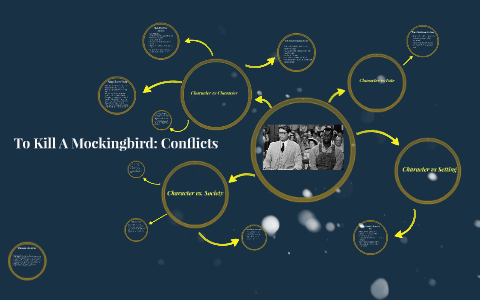Conflict in To Kill a Mockingbird:

Introduction
Internal conflict is a pivotal element in literature, catalyzing character development and plot dynamics. “To Kill a Mockingbird,” penned by Harper Lee, stands as a timeless classic renowned for its profound portrayal of internal conflicts. The novel delves deep into the intricate struggles of characters like Scout, Atticus, and Tom Robinson, presenting a rich tapestry of emotional turmoil and moral dilemmas.
These conflicts resonate with readers, evoking empathy and introspection. As we explore the internal conflicts within the pages of this literary masterpiece, we gain invaluable insight into the complexities of human nature and the enduring impact of such struggles. Join us on a journey to unravel the layers of internal conflict within “To Kill a Mockingbird” and discover the profound truths it reveals about the human experience
Understanding the Characters
Delving into the intricacies of “To Kill a Mockingbird,” we encounter a cast of characters grappling with profound internal conflicts that shape their journeys. Scout, Atticus, and Tom Robinson are emblematic of the emotional turmoil and moral dilemmas woven throughout the narrative. Through astute analysis, we unravel the depths of their internal struggles, from Scout’s coming-of-age dilemmas to Atticus’ unwavering moral compass in the face of adversity.
These characters serve as conduits for exploring universal themes of justice, empathy, and resilience, capturing the essence of human complexity. Join us as we navigate the labyrinth of these characters’ internal conflicts, gaining profound insights into the multidimensional nature of their experiences within the pages of “To Kill a Mockingbird.”
Nature of Internal Conflicts
Within “To Kill a Mockingbird,” a tapestry of internal conflicts unfolds, intricately woven into the fabric of the narrative. These conflicts encompass a spectrum of human experiences, from moral quandaries and societal injustices to personal growth and resilience in the face of adversity. As we peel back the layers of these conflicts, we unearth their profound influence on character development and plot progression, shaping the very essence of the story.
The resilience and moral fortitude displayed by the characters amidst these internal turmoils serve as a testament to the enduring impact of such conflicts. Join us as we embark on an exploration of the intricate nature of internal conflicts within “To Kill a Mockingbird,” unraveling their significance in driving the compelling evolution of characters and the narrative’s overarching trajectory.
Resolutions and Impact
Embarking on an exploration of “To Kill a Mockingbird,” we delve into the profound resolutions and gripping impact stemming from the characters’ internal conflicts. As we navigate the intricate webs of these conflicts, we witness the characters grappling with moral quandaries, societal injustices, and personal growth, each navigating their path to resolution. The impact of these resolutions reverberates throughout the storyline, shaping pivotal moments and character trajectories.
These profound resolutions serve as a testament to the enduring strength and moral fiber of the characters, illuminating the far-reaching impact of their internal battles. Join us as we unravel the compelling tapestry of resolutions and their reverberating impact within the pages of “To Kill a Mockingbird,” delving into the depths of human resilience and the transformative power of internal conflict.
. Lessons and Takeaways
As we immerse ourselves in the profound narrative of “To Kill a Mockingbird,” we are compelled to reflect on the invaluable lessons and poignant takeaways encapsulated within the internal conflicts of the characters. These conflicts act as conduits for broader themes and messages, resonating deeply with real-world experiences and the universal journey of personal growth. By drawing parallels to the complexities of our own lives,
we unravel the profound relevance of these internal conflicts, transcending the pages of the novel to impart enduring wisdom. Join us as we embark on a reflective exploration, delving into the timeless lessons and resonant takeaways derived from the internal conflicts within “To Kill a Mockingbird,” illuminating the transformative power of empathy, resilience, and the indomitable human spirit.
Mockingbird by Eminem about his daughter
The song “Mockingbird” by Eminem is indeed a heartfelt tribute to his daughter Hailie Jade, as well as his niece Lainie, whom he adopted. Eminem’s poignant lyrics and emotional delivery in the song reflect his deeply personal journey as a father and the complexities of family dynamics. The song encapsulates Eminem’s unwavering commitment to being a devoted and supportive father amidst life’s adversities.
While there may be artistic liberties taken for lyrical resonance, the genuine love and dedication Eminem expresses towards his daughter illuminate the profound emotional depth of “Mockingbird.” This touching narrative serves as a poignant reminder of the enduring bond between a parent and child, resonating with audiences on a deeply human level.
Who sang Mockingbird originally?
The song “Mockingbird” was originally written and recorded by Inez and Charlie Foxx in 1963. The brother and sister duo, with Inez on lead vocals and Charlie singing back-up and playing guitar, achieved widespread recognition with this soulful rendition of the song. Their interpretation of “Mockingbird” resonated deeply with audiences and became a top 10 hit, leaving an indelible mark on the music landscape. The song’s enduring appeal is a testament to the remarkable talent and artistry of Inez and Charlie Foxx, solidifying their legacy as influential figures in the realm of soul rhythm, and blues music.
Tom a mockingbird
In the timeless literary landscape of “To Kill a Mockingbird,” the character of Tom Robinson emerges as a poignant embodiment of the metaphorical mockingbird. As we traverse the intricate layers of Harper Lee’s narrative, we are compelled to unravel the profound significance of Tom as a mockingbird, encapsulating innocence, vulnerability, and unjust persecution. His unwavering kindness and inherent goodness echo the melodious innocence of the titular bird, yet tragically,
He becomes a victim of societal prejudice and systemic injustice. Join us on an evocative exploration as we delve into the parallels between Tom’s character and the symbolic essence of the mockingbird, unraveling the profound thematic depth and compelling relevance of his portrayal within the novel’s enduring tapestry of moral introspection and societal commentary.
Conclusion
In Harper Lee’s literary masterpiece “To Kill a Mockingbird,” the portrayal of internal conflict serves as a compelling lens through which the pervasive themes of racism, morality, and societal injustice are masterfully woven. The characters grapple with profound inner turmoil, reflecting the broader struggles embedded within the fabric of the racially charged, small-town setting. Scout’s journey to comprehend the enigmatic Boo Radley, Atticus’s moral quandaries in defending Tom Robinson, and the townspeople’s internal battles with prejudice collectively underscore the multifaceted nature of internal conflict within the narrative.
The significance of internal conflict in “To Kill a Mockingbird” resonates deeply, inviting readers on a poignant exploration of human struggles amidst an unforgiving social landscape. As characters confront their fears, uncertainties, and ethical dilemmas, the novel compels us to reflect on our complexities and the universal resonance of internal conflict. Through this introspective lens, Lee skillfully underscores the intricate interplay between personal conscience and societal norms, inviting readers to engage with the profound thematic depth and emotional resonance of the narrative.
By delving into the rich tapestry of internal conflicts, “To Kill a Mockingbird” encourages readers to reckon with the complexities of human nature, fostering empathy, critical thinking, and a deeper understanding of the enduring relevance of the novel’s portrayal of internal struggles.penguintalks.com




